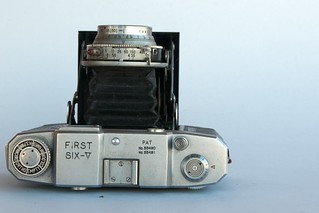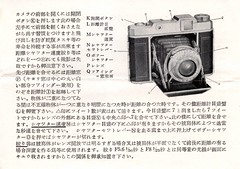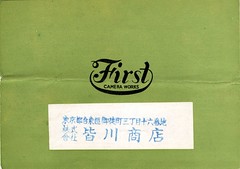First Six (postwar)
The postwar First Six (ファーストシックス) are Japanese 6×6cm folding cameras, made by Tokiwa Seiki from 1952 to 1956.[1] They are very different from the prewar and wartime First Six made by Kuribayashi. Both the prewar and postwar cameras were distributed by Minagawa Shōten, that was surely the owner of the "First" brand name.
Contents
General description
All the postwar models are horizontal folders, with three-part struts inspired from the Ikonta. These struts are engraved with the First logo inside an oval, that was already used by Minagawa in advertisements for the prewar models. The main body has polygonal ends. The name FIRST SIX is embossed on the leatherette covering of the front door.
The back is hinged to the right, as seen by the photographer, and is retained by a sliding bar on the left. The tripod socket is centred under the camera, and there are film flanges at both ends of the bottom plate. All the models have a front-cell focusing lens.
Original model
The original model is easily distinguished by its streamlined top housing, containing an eye-level finder and an angle finder placed side by side.
Description
The eye-level finder is placed right in the middle, and the angle finder is slightly offset to the left. The name is engraved at the front of the top cover, with the words FIRST and SIX on either side of the finder windows. The shutter release and folding bed release have an identical elongated shape and are symmetrically placed: shutter on the right, folding bed on the left. The advance knob is at the left end; it has knurls on the side and an arrow at the top to indicate the winding direction.
Commercial life
The original model was announced in Japanese magazines dated June 1952, and advertised from July 1952 to March 1953.[2] The advertisements placed in the September and November 1952 issues of Asahi Camera list the camera with a First Anastigmat 75/3.5 coated lens and a Compur-like shutter (five blades, 1–400) synchronized via an ASA bayonet post.[3] The text mentions the ability to take 6×6cm and 4.5×6cm exposures, by way of a mask.
The English instruction sheet mentions two models: the model I with Compur-type shutter (B, 1–400) and the model II with Prontor-type shutter (B, 10–200).[4] (The model I is not to be confused with the later First Six I, released in 1955.)
The pictures displayed in the advertisements and in the instruction sheet show the marking around the viewfinder as First Six in lowercase letters instead of capital letters, but this might result from a retouch to the pictures.[5]
Actual examples

|
| First Six, original model I, First Anastigmat 7.5cm f/3.5 no.3676, MSK-II. Picture courtesy of Scott at www.collectiblecameras.com. (Image rights) |
Both single and dual format cameras have been observed, though the single format variant seems more numerous.[6] Single format cameras have a single red window in the middle of the back, with a horizontally sliding cover inscribed 6X6, whereas dual format cameras have an additional window placed above, with a similar cover presumably inscribed 4.5X6. Some single format examples have an additional diamond-shaped marking on the metal plate surrounding the red window, whose meaning is unknown.
All the cameras have a First Anastigmat 7.5cm f/3.5 lens; lens serial numbers are known in the 19xx to 39xx range. Most examples, corresponding to the model I, have an MSK-II shutter (B, 1–400, ASA synch), with the shutter name MSK–II sometimes engraved in red and sometimes in black.[7] A single example of the model II has been observed so far, with a simpler unmarked shutter (B, 10–200, self-timer, ASA synch).[8]
The First Six V and VA
 
|
| First Six V 6x6 and 6x4.5 with Tri-Lausar Anastigmat f/3.5 80mm (sn 5148) in MSK-III shutter (B, 1-400) images by Dirk HR Spennemann (Image rights) |
Description
The First Six V has a redesigned top cover, containing an uncoupled rangefinder combined with the viewfinder. The rangefinder is controlled by a wheel falling under the right thumb, with a disc placed above with a distance scale. The top plate carries the inscription "FIRST SIX–V" as well as two patent numbers PAT No.33490 No.33491.
The camera always has dual format ability, with red windows similar to those of the previous model, and two vertical red lines in the viewfinder delineating the field of view for 4.5×6cm exposures.
Commercial life
The First Six V was advertised in Japanese photography magazines from April 1953 to June 1954,[9] and the cheaper First Six VA was advertised from September 1953.[9] In the advertisements placed in Asahi Camera from September 1953 to June 1954, the two cameras are listed with a Tri-Lausar 80/3.5 lens.[10] They are distinguished by the shutter: the model V is advertised with an MSK (1–400) and the model VA with an NKS (1–200, self-timer).
Prices are indicated from January to June 1954, but they were certainly swapped: the model V is listed at ¥12,000, cheaper than the model VA at ¥13,500.[11]

|

|
| Advertisement in Asahi Camera October 1953 (that dated September 1953 is nearly identical). (Image rights) | Advertisement in Asahi Camera January 1954 (those dated November 1953 and February to June 1954 are nearly identical). (Image rights) |
Variations and actual examples

|
| First Six V, very early, First Anastigmat 7.5cm f/3.5 lens no.3697. From Asahi Camera September and October 1953. (Image rights) |
An extremely early example of the First Six V is pictured in the September and October 1953 advertisements.[12] It has a First Anastigmat 7.5cm f/3.5 lens (no.3697), similar to that of the original model, and certainly an MSK shutter. The advance knob is knurled and has a tronconical shape at the top. A similar camera, with lens no.3711 and an MSK-II shutter, is pictured in an early instruction sheet.[4]
Slightly later cameras have a rimmed advance knob. That pictured in the Japanese instruction manual, reproduced below, has a three-element Tri-Lausar Anastigmat C 80mm f/3.5 lens by Tomioka in an MSK-II shutter. Another example is known with a First Anastigmat C 7.5cm f/3.5 in an MSK-III, and yet another has been observed with a Tri-Lausar Anastigmat C 80mm f/3.5 in an MSK-III.[13]
  
|
  
|
| Instruction manual of the First Six V, in Japanese. (Image rights) |
On mid-production cameras, the standard lens and shutter combination is the Tri-Lausar with MSK-III. The advance knob was replaced again by a different part with thick knurls and a flat top, then by another with vertical mills and a film reminder at the top.[14]
After some time, the distance scale above the rangefinder wheel was replaced by a larger part with a flat top. At least one such camera has been observed with a Tri-Lausar lens and an NKS shutter (B, 1–200, self-timer) with PC socket, corresponding to the First Six VA.
On yet later cameras, the rangefinder's distance scale was replaced again by a different part with a recessed top, and a hinged lock was added above the main release button. At the time, the Tri-Lausar lens was replaced by a Neogon Anastigmat 8.0cm f/3.5, with a black bezel. At least one example made during that period is known with a Ceres shutter (B, 1–300, self-timer), synchronized via a PC socket at the top.[15] Another camera has been observed with an unknown shutter whose PC synch post is located at the bottom, towards the front.[16]
The First Six III
The First Six III is a version that was announced in Japanese magazines dated November and December 1954,[9] and about which little is known. It reportedly has auto-stop advance for 6×6cm exposures, and manual advance via a red window for 4.5×6cm.[9] The lens is reported as a First 85/3.5, and the shutter as B, 1–200, with self-timer and synchronization.[9] No example of the First Six III has yet been observed, and this model was perhaps never sold.[17]
The First Six I (new model)
Description
The new model of the First Six I, released in 1955, has yet another top housing, containing two separate viewfinders, one for each exposure format. The two windows are arranged at the front so as to look like a rangefinder camera, a kind of deception used on other Japanese cameras of the time, such as the Atom Six. The viewfinder for 6×6cm exposures is offset to the right and has a larger size, and that for 4.5×6cm exposures is smaller and offset to the left. The name FIRST SIX is engraved on a metal plate surrounding both viewfinders, between the two windows.
The camera apparently has manual advance, driven by a knob at the top left. There is an accessory shoe at the top right, behind the shutter release.
Commercial life
The new First Six I was featured as a new product in the September 1955 issue of Sankei Camera, and was advertised in Japanese magazines from September 1955 to April 1956.[9] The September 1955 advertisement in Sankei Camera lists the camera with a Neogon 80/3.5 lens and a synchronized shutter giving B, 10–200 speeds.[18] The price is quoted as ¥5,600.
Actual examples
The only examples of the new First Six I observed so far are those pictured in Sugiyama, one of which is misidentified as a "First Six III".[19] Both have a Neogon Anastigmat 8.0cm f/3.5. One camera has a film reminder in the advance knob and a Rectus shutter (B, 1–200) with an ASA synch post at the top. The other camera has a First shutter (B, 10–200) with a PC socket at the bottom, towards the front, whose name FIRST is inscribed in small characters on the front plate, under the lens. This camera has no film reminder.
First Six with single viewfinder
One isolated example of the First Six has been observed with a single viewfinder in a top housing that is otherwise quite similar to that of the new First Six I.[20] The camera has an accessory shoe and film reminder. The film advance is manual, controlled by two red windows in the back, as on the First Six V. The model name for this version is unknown; it only has the engraving FIRST SIX on the top plate, above the viewfinder.
Notes
- ↑ Date: Kokusan kamera no rekishi, p.361.
- ↑ Kokusan kamera no rekishi, p.754. The camera is mistakenly dated 1958 and called "First Six (New Model-I)" in Sugiyama, item 1300.
- ↑ Advertisements reproduced in Kokusan kamera no rekishi, pp.169–70.
- ↑ 4.0 4.1 Instruction sheet reproduced at Butkus.org.
- ↑ Advertisements reproduced in Kokusan kamera no rekishi, pp.169–70, and instruction sheet reproduced at Butkus.org.
- ↑ Dual format: example observed in a Japanese online auction. Single format: examples observed in various online auctions.
- ↑ Examples pictured in this page, in McKeown, p.922, and observed in online auctions and for sale by online dealers.
- ↑ Example pictured in Sugiyama, item 1300.
- ↑ 9.0 9.1 9.2 9.3 9.4 9.5 Kokusan kamera no rekishi, p.361.
- ↑ Advertisements in Asahi Camera September 1953, p.102, October 1953, p.97, November 1953, p.143, January 1954, p.97, February 1954, p.103, March 1954, p.89, April 1954, p.81, May 1954, p.159, and June 1954, p.165. Those dated September and October 1953, and March 1954, are also reproduced in Kokusan kamera no rekishi, p.170.
- ↑ Advertisements in Asahi Camera January 1954, p.97, February 1954, p.103, March 1954, p.89, April 1954, p.81, May 1954, p.159, and June 1954, p.165. That dated March 1954 is also reproduced in Kokusan kamera no rekishi, p.170.
- ↑ Advertisements in Asahi Camera September 1953, p.102, and October 1953, p.97. They are also reproduced in Kokusan kamera no rekishi, p.170.
- ↑ Examples observed in online auctions.
- ↑ Examples observed in online auctions.
- ↑ Example observed in an online auction.
- ↑ Example observed in an online auction.
- ↑ The camera pictured as a "First Six III" in Sugiyama, item 1298 is actually a First Six I (new model).
- ↑ Advertisement reproduced in Kokusan kamera no rekishi, p.170.
- ↑ Sugiyama, items 1297–8.
- ↑ Example pictured in Ryoma_Photo's Hatena Fotolife gallery [1] [2] [3] [4].
Bibliography
Original documents
- Asahi Camera. Advertisements by Minagawa Shōten:
- September 1953, p.102;
- October 1953, p.97;
- November 1953, p.143;
- January 1954, p.97;
- February 1954, p.103;
- March 1954, p.89;
- April 1954, p.81;
- May 1954, p.159;
- June 1954, p.165.
- First Camera Works. First Six. User manual for the First Six V published c.1953, date not indicated. Document reproduced in this Flickr album by Rebollo_fr.
Recent sources
- Asahi Camera (アサヒカメラ) editorial staff. Shōwa 10–40nen kōkoku ni miru kokusan kamera no rekishi (昭和10–40年広告にみる国産カメラの歴史, Japanese camera history as seen in advertisements, 1935–1965). Tokyo: Asahi Shinbunsha, 1994. ISBN 4-02-330312-7. Items 754–7. (See also the advertisements for items 748, 751 and 753.)
- Lewis, Gordon, ed. The History of the Japanese Camera. Rochester, N.Y.: George Eastman House, International Museum of Photography & Film, 1991. ISBN 0-935398-17-1 (paper), 0-935398-16-3 (hard). Pp.75, 79 and 83 (brief mentions only).
- McKeown, James M. and Joan C. McKeown's Price Guide to Antique and Classic Cameras, 12th Edition, 2005-2006. USA, Centennial Photo Service, 2004. ISBN 0-931838-40-1 (hardcover). ISBN 0-931838-41-X (softcover). P.922.
- Sugiyama, Kōichi (杉山浩一); Naoi, Hiroaki (直井浩明); Bullock, John R. The Collector's Guide to Japanese Cameras. 国産カメラ図鑑 (Kokusan kamera zukan). Tokyo: Asahi Sonorama, 1985. ISBN 4-257-03187-5. Items 1297–300.
Links
In English:
In Japanese:
- First Six V (late) at Inadani's camera page
- Pictures of a First Six with a single viewfinder [5] [6] [7] [8] in Ryoma_Photo's Hatena Fotolife gallery
